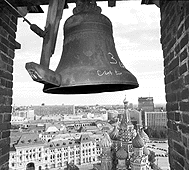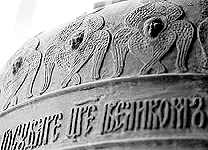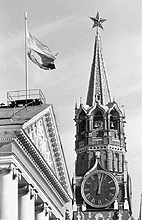 |
|
|
|
 |
For Whom the Bells Toll |
|
Bells in Spasskaya Tower now resound every three hours with melodies by famous Russian composer Mikhail Glinka. Valeria Korchagina listens in on the process and learns about the tower's long and tumultuous history.
Aug. 9, 1996, the day President Boris Yeltsin was inaugurated, a smaller but still-important event in Russia's history took place. Just minutes before the president read his oath to the nation, flat bells inside the clock on the Spasskaya Tower played the melody of Russia's wordless national anthem, Mikhail Glinka's "Patriotic Song."
The performance marked the return of a 300-year-old tradition. While passers-by can see the large, traditionally shaped bells that hang from the tower and mark the time, the flat bells of Spasskaya Tower are hidden inside. It had been 76 years since the tower had housed bells capable of sounding a melody.
Now the flat bells ring every three hours, playing either "Patriotic Song" or another Glinka classic, "Slasvya," and visitors who wander into Red Square during these times are likely to be taken aback by the beauty of the Russian songs echoing across the architectural heart of the country. But, for the bell's technical crew, there is still a lot of fine-tuning in the works.
Inscriptions in Old Church Slavonic grace Spasskaya Tower's original bells.
Improving the sound of the bells is just one of a number of challenges facing the bell workers. The electrical engine that, in essence, rings the flat bells needs to work more quickly. The tower itself is on shaky ground. Even more worrisome are rumors that a Dutch bell-making company is trying to move into the Russian market by replacing the flat Russian bells at Spasskaya Tower with new Dutch bells. Not surprisingly, the mere suggestion of this possibility has infuriated the tower's bell experts.
"Why, at a time when Russian bells are being exported to places as remote as Cyprus, should we put Dutch ones on the Spasskaya Tower?" asks Igor Konovalov, the Kremlin's chief bell-ringer. "It is fine to buy something abroad if we can not produce it ourselves. But Russia has always been famous for its bells."
The long history of Russian bells, Spasskaya Tower holds a special place. The tower has always been a major entrance to the Moscow Kremlin, used by boyars, tsars, emperors, foreign ambassadors and the church elite; and the bells inside it have played a key role in setting the time for Moscow.
The current tower was built in 1491, and although it is renowned as a superb example of traditional Russian architecture, it was actually designed and built by an Italian architect, Pietro Antonio Solari. The tower got its tent-like roof between 1624 and 1625, and it is the enclave under this roof that now houses the flat bells.
Shortly after the current tower was built, Tsar Mikhail Feodorovich, the grandfather of Peter the Great, installed a new clock. In those days, the system for telling time was very different from the system used today. Counting started with sunrise, measuring only the time during the day, and after sunset the clock would be reset for the night.
In addition, responsibility for accurate time-keeping depended almost entirely on the individual who oversaw the bells in Spasskaya Tower. In a petition from that era, the time-keeper from the Kremlin's Troitskaya Tower wrote: "In the year of our Lord 1688, the time-keeper of Spasskaya Tower passed away. At his death, his widow Ulita was left childless and kinless. She resides in the Spasskaya Bashnya and fails to maintain the clock according to regulations. Oft-times she sounds the hour, confusing day and night; it happens that she lengthens one hour into two, and of late she has taken to hastening two into a single hour."
Nevertheless, the clock was considered to be one of the great sights a visitor could encounter in Moscow. As one traveler wrote: "There is a giant tower above the gates, built high and on a strong basement, upon which a wonderful town clock is placed. The clock is famous worldwide for its beauty and its mechanical workings, as well as for the sound of its big bell, which can be heard not only in town but in the villages nearby."
 In
the beginning of the 18th century, Peter the Great ordered Russia to switch
to the current system of dividing the day into 24 equal hours. He also
ordered changes to the clock on Spasskaya Tower, requesting "bells, music
and dances."
In
the beginning of the 18th century, Peter the Great ordered Russia to switch
to the current system of dividing the day into 24 equal hours. He also
ordered changes to the clock on Spasskaya Tower, requesting "bells, music
and dances."
In 1706, one day at noon, music was played by the bells for the first time. The installation of the bells was fully completed by 1709, but time was ruthless to the clock. It frequently broke down and required endless repair work. After a fire in 1737, the clock was damaged beyond repair.
Thirty years later, a new clock was introduced. It also didn't last long, and in 1850 another major repair was conducted. The clock faces were redesigned into their current format, and new melodies were used.
In 1917, during the revolution, the tower was damaged once again, this time by cannon shells. According to some accounts, Vladimir Lenin in 1918 gave an order that the bells should play "The International" and another revolutionary song - but it seems the order was never fulfilled.
In any case, although the bells marking time have been pealing for decades, it wasn't until this year that bells again resounded with Russian melodies.
EVERY day, at exactly 12 noon, a tall, inconspicuous-looking man with dishevelled dark hair walks quietly on to Red Square, cocks his ears and listens carefully to the 40-second bell-song of the Russian national anthem. This man, Oleg Tsitsinov, is responsible for ensuring that the bells are in tune and that the song is performed correctly.
Tsitsinov, 52, is one of a small cadre of experts whose life's work now involves the bells on Spasskaya Tower. A pianist by training, Tsitsinov feels honored by his current work. "I really enjoy the specialness of this task, and the fact that I am working in a unique spot like Spasskaya Tower," he says. "It's a real chance for me to apply both my knowledge of bells and my education as a professional musician."
Another key worker in Spasskaya Tower is Yury Zhebelev, an engineer who runs a firm that oversees technical work in the Kremlin. Igor Konovalov, head bell-ringer of the Moscow Kremlin and the personal bell-ringer of Patriarch Alexy II, rounds out the trio of bell-tower experts.
Zhebelev, 51, started to work in the Kremlin in 1991, providing protective doors for an exhibit of artifacts. From there, various work contracts developed, and he eventually ended up working primarily on projects for the Kremlin. He has no complaints. "I derive enormous gratification from working on large projects," he says. "Before I took up the Kremlin project, I assembled massive production lines and built cranes and mixers for cast iron."
Konovalov has considerable other duties besides his work at the bell tower. His main job is following Patriarch Alexy II during his daily travels and ensuring the quality of the bell-ringing during the services conducted by the Patriarch. Rather surprisingly, on most occasions the chief bell-ringer does not actually ring any bells, just stands back and listens.
Although Konovalov is usually casually dressed in rumpled old suits, he transforms easily into a church official dressed in a black cassock, according to the strict Orthodox code. When the Patriarch's entourage arrives, he manages to be near the religious leader while also ensuring that he can be seen from the bell-tower of the church where a service will take place.
As the Patriarch's car approaches a church, Konovalov starts to conduct what seems to be an invisible orchestra - the standard church bells that ring with a mixture of intricate clanging. He is in fact conducting the bell ringing in a tower that may be as far as 100 meters away.
When the Patriarch is not busy conducting services, Konovalov is also the chief bell-ringer in the Kremlin, but even then he rarely actually rings bells. He works from what must be one of the world's most spectacular offices, right in the middle of the Ivan the Great bell tower.
Oleg Tsitsinov and Yury Zheblev standing by the drum mechanism that propels the system of gears for ringing Spasskaya Tower's bells.
How do the bells in Spasskaya Tower actually ring? Banish all thoughts of a man and a clanger. The traditionally shaped bells that can be seen hanging from the tower sound every quarter of an hour to mark time, thanks to a mechanical system run by an electric engine that connects the clock and the bells.
The flat bells, which look like metal plates, are hidden inside Spasskaya Tower and work with a slightly different system. Scaffolding supports the 12 of them, which are surrounded by a cobweb of metal hawsers, and a system of gears leads to a mechanical device known as a drum that is connected to the clock three floors below. The drum works like the device in a music box, but on a much larger scale.
To create music from silence, Konovalov said the first challenge was fixing the drum. The next step was finding bells that would ring with the right tone for Russian melodies. A decision was made to use flat bells, Konovalov says, because they were used in Russia long before traditionally shaped bells were brought here from Europe in the 12th century.
New bells were necessary because most of the original ones were lost over time, and the bells that weren't lost were ruined before the revolution by amateur bell workers.
Another reason was purely practical. Flat bells are relatively light and easily accommodated into the tower, while traditionally shaped bells are usually very heavy and would have brought the total bell weight in the tower up to 16 tons. "If we were to find bells in the tones that we need to play our me lodies, they would have to be so big that they would not even fit on the tower," says Zhebelev.
Now that the flat bells have been installed - a work initiated by Valery Gorelov, the deputy commander of the Moscow Kremlin, and speeded by a decree from President Yeltsin - there is still more to be done. The flat bells are currently held in place by a temporary system of scaffolding, which the bell experts hope will be replaced by a system of permanent supports. While Tokobank financed the first stage of the project, financing for the second stage remains to be found.
This is not the only area in need of improvement. "We depend now entirely on the electric engine that has been in the tower for years," Tsitsinov says. Until this engine is upgraded, the melodies will be played more slowly than they should be.
The bell experts are primarily concerned, however, with rumors that a high official in the Kremlin is lobbying on behalf of a Dutch bell-making firm that reportedly intends to replace the flat bells with its own bells.
The team is furious. Aside from their patriotic objections, they say Dutch bells do not ring nearly as well as Russian ones and will undoubtedly be too heavy. It is also unlikely that they will match the old Russian tones used for the clock.
"The tones of those bells are so much higher that they will be out of sync with the style of Glinka's melodies, as well as with the whole architectural complex of the Red Square," says Tsitsinov. "Moscow is not some small European town. If Dutch bells are installed they will not have any connection to the environment."
Attempts to discover the status of the foreign bell purchases were unsuccessful. Like the echoes of the bell-songs themselves, it is difficult to trace an exact beginning and end for the rumor. Numerous sources inside the Kremlin said negotiations are ongoing, but no final decision is in sight.
Spasskaya Tower as seen from inside the Moscow Kremlin. (PHOTOS: IGOR TABAKOV/SPT)


